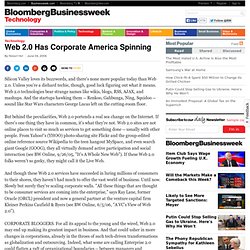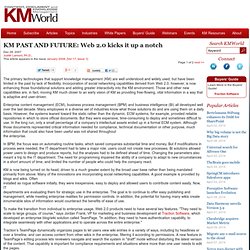

Web 2.0 Has Corporate America Spinning. Silicon Valley loves its buzzwords, and there's none more popular today than Web 2.0.

Unless you're a diehard techie, though, good luck figuring out what it means. Web 2.0 technologies bear strange names like wikis, blogs, RSS, AJAX, and mashups. And the startups hawking them -- Renkoo, Gahbunga, Ning, Squidoo -- sound like Star Wars characters George Lucas left on the cutting-room floor. But behind the peculiarities, Web 2.0 portends a real sea change on the Internet.
If there's one thing they have in common, it's what they're not. And though these Web 2.0 services have succeeded in luring millions of consumers to their shores, they haven't had much to offer the vast world of business. CORPORATE BLOGGERS. Early signs of the shift abound. Just as the personal computer sneaked its way into companies through the back door, so it's going with Web 2.0 services.
ONE GIANT COMPUTER. PROBLEM SOLVING. MORE FLEXIBLE. The big advantage: They can be done very quickly with existing Web services. What Is Web 2.0 Anyway? KM PAST AND FUTURE: Web 2.0 kicks it up a notch. The primary technologies that support knowledge management (KM) are well understood and widely used, but have been limited in the past by lack of flexibility.

Incorporation of social networking capabilities derived from Web 2.0, however, is now enhancing those foundational solutions and adding greater interactivity into the KM environment. Those and other new capabilities are, in fact, moving KM much closer to an early vision of KM as providing free-flowing, vital information in a way that is adaptive and user-driven. Enterprise content management (ECM), business process management (BPM) and business intelligence (BI) all developed well over the last decade. Many employees in a diverse set of industries know what those solutions do and are using them on a daily basis.
However, the systems leaned toward the static rather than the dynamic. In BPM, the focus was on automating routine tasks, which saved companies substantial time and money. What Is Web 2.0. By Tim O'Reilly 09/30/2005 Oct. 2009: Tim O'Reilly and John Battelle answer the question of "What's next for Web 2.0? " in Web Squared: Web 2.0 Five Years On. The bursting of the dot-com bubble in the fall of 2001 marked a turning point for the web. Many people concluded that the web was overhyped, when in fact bubbles and consequent shakeouts appear to be a common feature of all technological revolutions. Shakeouts typically mark the point at which an ascendant technology is ready to take its place at center stage. The concept of "Web 2.0" began with a conference brainstorming session between O'Reilly and MediaLive International.
In the year and a half since, the term "Web 2.0" has clearly taken hold, with more than 9.5 million citations in Google. This article is an attempt to clarify just what we mean by Web 2.0. In our initial brainstorming, we formulated our sense of Web 2.0 by example: The list went on and on.